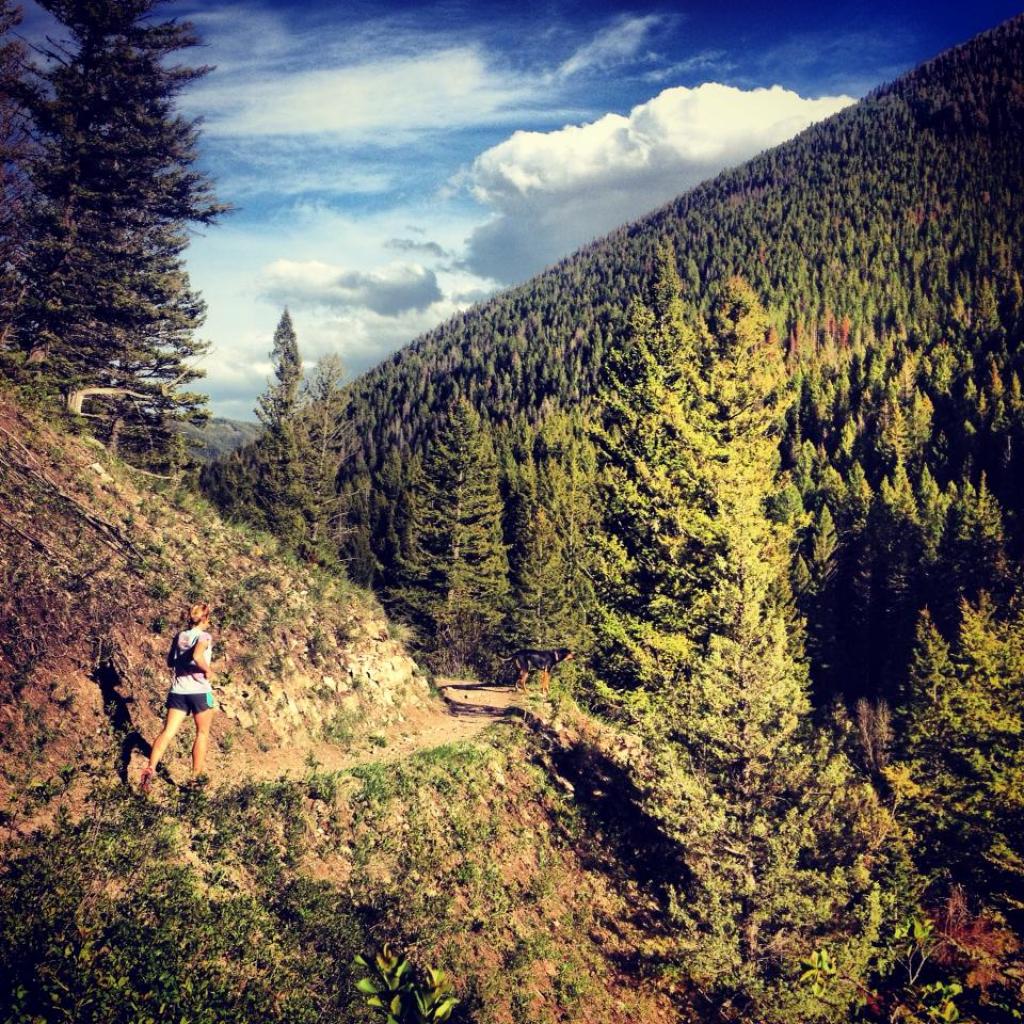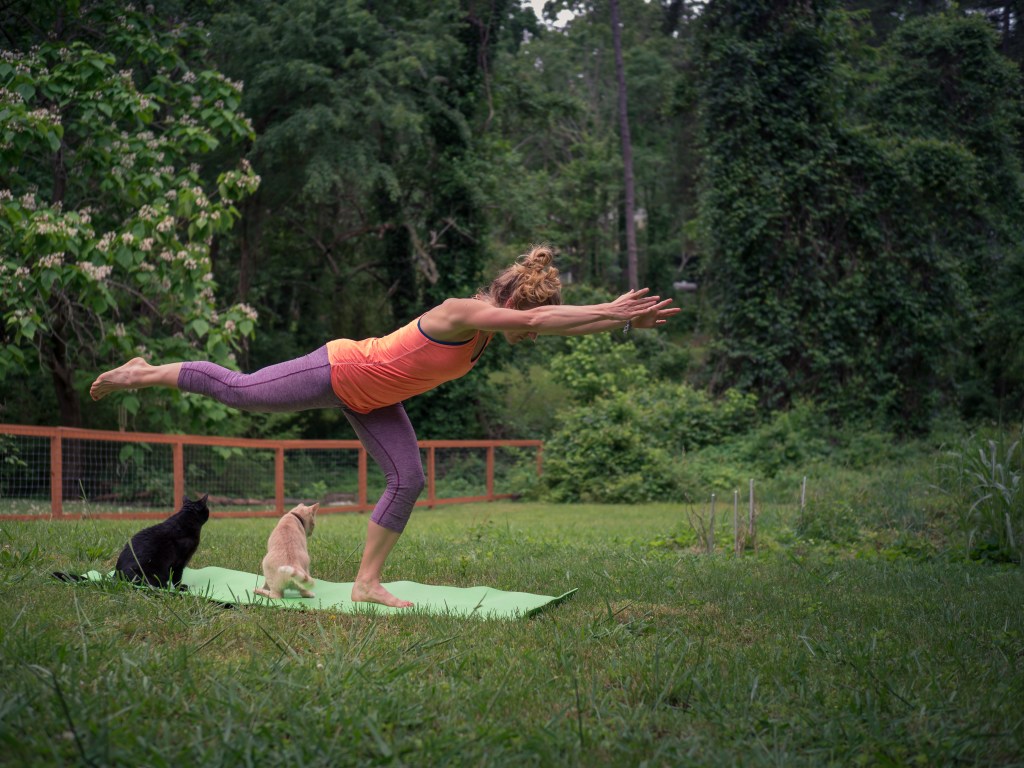When she’s not speeding by on the trails of Pisgah, you can find her teaching yoga, writing and producing running films.
The Southeast is a hotbed for outdoor activity, but the trail running mecca is Asheville, North Carolina. When planning my Trail Sisters Road Tour, Asheville was a must on my list. Not only because it borders the Pisgah National Forest and is chock-full of mountainous trails, but also because my fellow trail sister Ashley Hunter Arnold lives there.
I met Ashley in 2012 in Carbondale, Colorado, when we both worked for Trail Runner magazine and were training at a competitive trail racing level. Training with Ashley was always refreshing. Her outlook on running was pure and with a strong intent to connect with the nature around her.
Ashley is a bit of a renaissance woman. She runs competitively, dances, teaches yoga and identifies as an artist and “cat mom” to Fugazi and Pharaoh. “I’m a Libra, so it seems my life is all about seeking balance,” she says.
I reconnected with Ashley in Asheville to learn more about why she runs, the local running community and what her future holds.
You’ve been an athlete your entire life across multiple sports. What was it about running that caught your attention?
I was a competitive gymnast from the time I could walk until I was a freshman in high school. I quit because I was acting in a lot of plays and needed more free time for rehearsals. After being so active and competitive for my whole life up to that point, I didn’t last long without a sport.
My sister was a runner and she convinced me to start track. I only wanted to run short and fast in the beginning. I was a hurdler for the first few years of my running life. In fact, I refused to run more than 400 meters at a time. I was the 300-meter hurdle state champ my sophomore year of high school. And then I found distance running. I switched to the mile and then eventually was recruited to run distance in college.
I quit running in college my freshman year, though, and didn’t really come back to it with any regularity until I moved to Colorado in 2009 and started running trails. That’s when I really rediscovered my love for it.
Running, I believe, forces us to face ourselves in a way that nothing else can. Running teaches discipline and presence and helps us learn to be strong in the face of adversity. At the same time, running creates community in a real and lasting way.
To dive deeper into your interest in trail running, what is it that you love most about the sport, and why do you continue running today?
You could say that trail running brought me back to life. I found the sport at a time when I felt pretty lost and uncertain about who I was and the direction I was going. I’ve always loved trail running for the connection with land—the visceral experience of it. It’s not really even about the running. Running trails is really just this means to explore more and cover more ground in beautiful, inspiring and wild places. It’s a path to quiet, to stillness.
That said, I love running. I can run anywhere. I can run around a hotel parking lot if I have to (and I have had to). But I love wilderness. And trail running has always been therapeutic for me because it’s allowed me to do one of my favorite things in the world in some of the most beautiful places in the world. But that’s not the main reason I run. Running, for me, is about discipline. It’s about learning to push myself. Learning to be comfortable with discomfort. Learning to accept myself. It’s also about freedom. And creativity. If I can achieve my goals in running, I can achieve my goals in life.

Photo courtesy of Blair Speed
What’s the running community like in Asheville?
I’ve never been around a more inspiring and welcoming group of people. The running community here is inviting and inclusive and supportive.
Monday nights the NC Mountain Trail Runners meet at Bent Creek Experimental Forest for some easy trail miles. There are different pace groups so it’s easy to find folks to run with.
Tuesday night is Track Night. We all meet at 6:30 p.m. at Jus’ Running. The workout is led by Asheville running legend, Norman Blair. Sometimes there’s upwards of 60 people there (all levels).
I’m now on a running team in town called the Asheville Running Collective (newly added women’s team, actually) and we put on a group run every Thursday night that starts at the Wedge, an awesome brewery in town. (I like the Ironrail IPA.) A lot of us use this night as a second workout night for long repeats or tempo runs.
And every weekend—or any day of the week really—you can find at least one person heading out into the wilderness for an adventure. There are hundreds of miles of pristine singletrack in Pisgah, much of which I haven’t explored. And, waterfalls abound, a very good thing since it gets so humid in summer months.
You’ve worked for Trail Runner, are the gear editor and contributor for TrailSisters.net, and have a film business that produces running films. What moves you to share your voice and creativity in the sport through these outlets?
I’ve always been a writer. And I’ve always loved film. When I left Trail Runner, I had an opportunity to create product videos for several different outdoor brands. It opened up a whole new world of possibilities for me to tell stories in a different way. Since then, I’ve been fortunate to work with quite a few talented filmmakers on projects over the years and, today, I work mostly with my partner Austin and his brother, Maitland. We have a production company called Trine Films. We actually just wrapped editing a running travel show we produced with Fleet Feet Sports called Run This Town.
You also teach yoga. Tell me why this type of movement is important for runners.
Running, for the most part, is a forward-moving activity. When we’re constantly moving in one direction, we automatically lack balance from a purely physical level and often find we need to strengthen the parts of our bodies that grow weak from repetition.
We’re also missing the opportunity to move dynamically in space—front, side, back, diagonally—if we only run, and that causes a more nuanced imbalance in our spiritual and emotional body. While running is freeing, the movement pattern is fairly structured. More intuitive movement, like certain types of dance, for example, provide a much-needed element of freedom. The right combination of the two, which differs from person to person, works to create physical balance and, from my experience, a lower incidence of injury.

Photo courtesy of Ashley Hunter Arnold
What’s next for you?
I plan to continue to write and share and teach in a meaningful way through word, video and in person with workshops and classes. I also hope to inspire people to move in balance through their lives in order to not only reach and exceed their goals but also live more fully and mindfully in the present moment. And I hope to continue to be a part of building lasting community through the power of this sport.
I’ve also returned to training for shorter distances, which is something I’ve always regretted a bit since I walked away from the track my freshman year of college. I have goals for sure, but I will take things as they come. For now, I’m still adjusting to regular speed training and more consistent volume, which is something I actually haven’t done since I was 19. I’m excited to see where it takes me over the next couple of years.
Follow Ashley on Instagram at @ashleyharnold.
[ed. note: This interview has been edited for length and clarity.]
